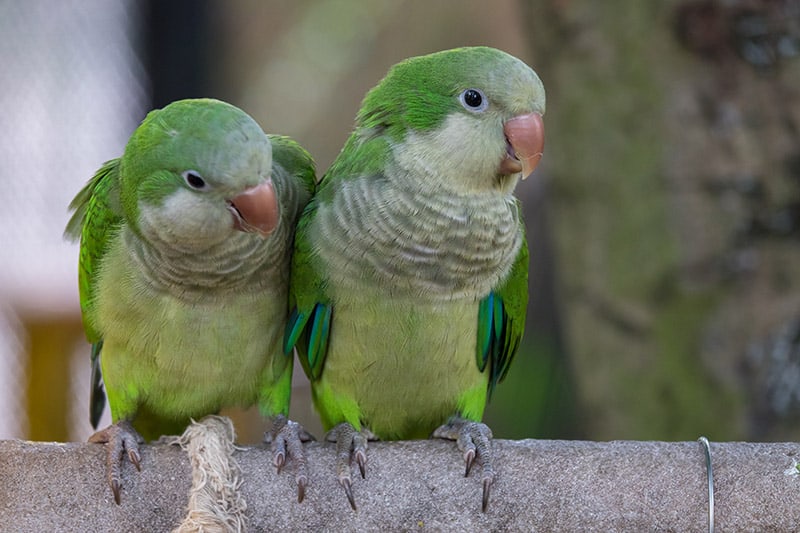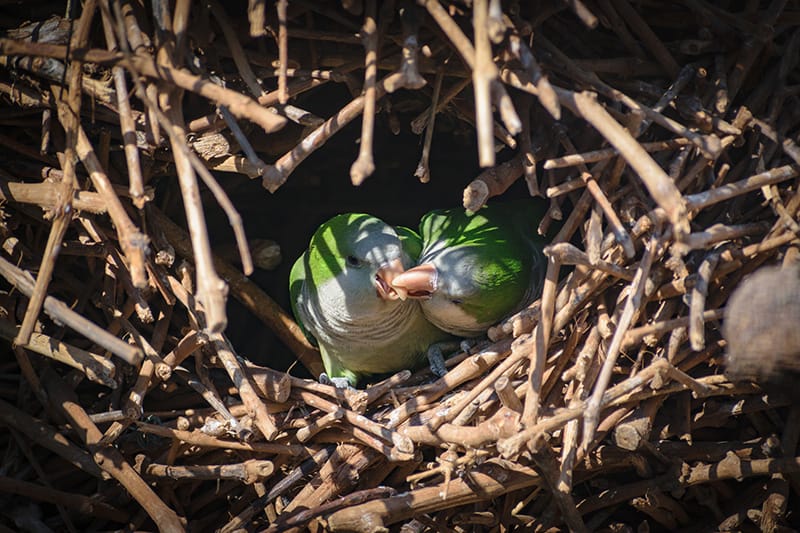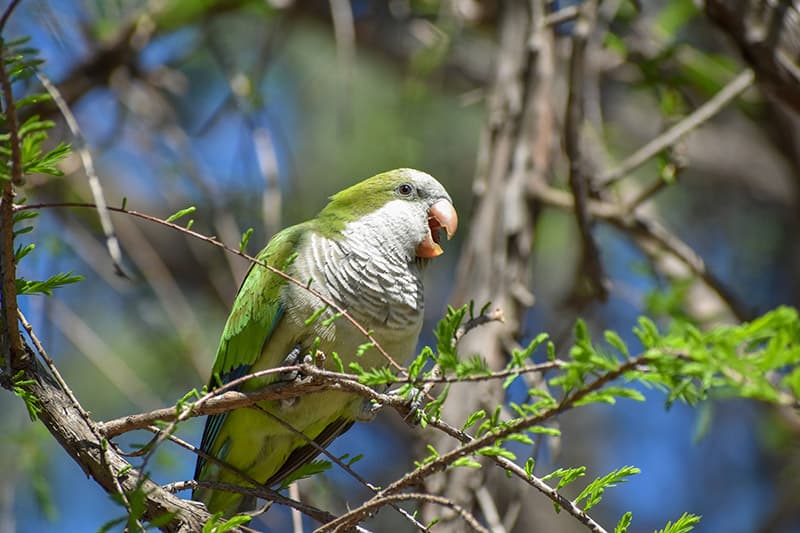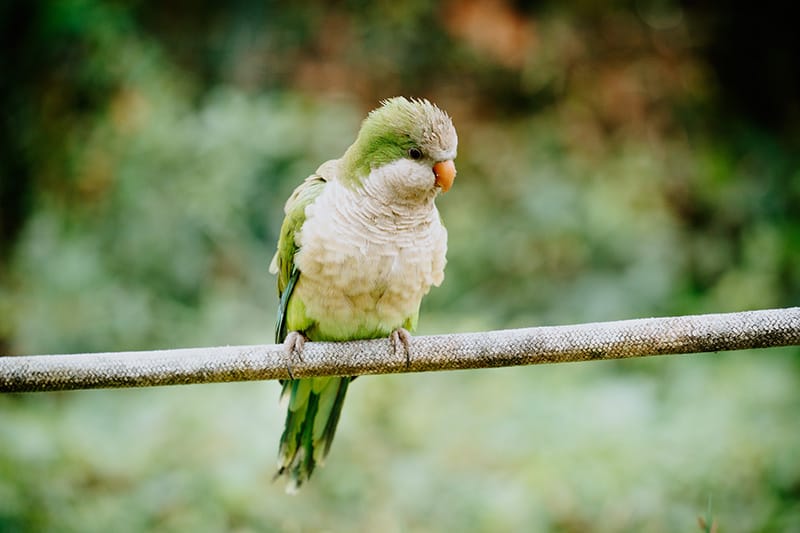Quaker or “Monk” parakeets are some the nicest birds around! They are good talkers and are extremely loveable and cute.
The Quaker Parakeet or Monk Parakeet is very charming! This inquisitive bird is a great talker, enjoys human interaction, head scratching and cuddling. They are hardy, adaptable, and easy to breed. With good socialization they can be very calm and peaceful, one of the best companions! Quaker “Monk” Parakeets are considered a very good “first” bird!
Because the Quaker Parakeet or Monk Parakeet have established themselves in areas other than their original habitats, notably in Puerto Rico and in northeastern parts of the United States, they are not legal to own or keep in all states. To find out if they are legal to own in your state, click here:
Quaker Parakeet Legality.
- To learn more about Parakeets and their needs visit: Guide to a Happy, Healthy Parakeet
Scientific Classification
| Kingdom: | Animalia |
| Phylum: | Chordata |
| Class: | Aves |
| Order: | Psittaciformes |
| Family: | Psittacidae |
| Genus: | Myiopsitta |
| Species: | monachus |
Scientific name

Description
These parakeets are generally quiet birds and their sweet disposition makes them exceptional pets. The Quaker Parakeet gets it’s name from the facial feathering that has a gray bibbed pattern, resembling an old fashioned Quaker costume. Besides being known as Quaker Parakeet and Monk Parakeet, they are also called Green Parakeet, Grey-breasted Parakeet, and Montevideo Parakeet. This is the only member of it’s species and there are 4 subspecies mostly distinguished by size and color intensity.
The Quaker “Monk” Parakeets cheeks, throat, crown and lores are gray. It’s upper breast is gray with light edges, giving them a scalloped appearance and the lower breast is yellowish. The back of the head, neck, rump, wings and the rest of the under parts are green, and there can be some blue outer feathering. It has a long, pointed tail with a mixture of yellow and bluish green. The female is lighter in coloring than the male.
The normal green Quaker Parakeet is by far the most common, but other mutations are also available including yellow, blue, pied, and albino varieties. The young birds have a gray forehead with a green tinge. These birds grow to a length of 11-12″ (29-30 cm).
Distribution
The Quaker Parakeet or Monk Parakeet is found in South America, central Bolivia, southern Brazil, parts of Argentina, and Uruguay. Recently they have established themselves in other areas like Puerto Rico, and northeastern United States.
Care and Feeding
Fresh food and water must be provided daily. Quaker “Monk” Parakeets eat a variety of sprouts, seeds, fruits, vegetables, and commercial pellets. They like nuts with the shells cracked, such as walnuts, pecans and almonds. They also enjoy the same nutritional foods humans eat, including cooked chicken. Cooked beans, rice, and grains are also enjoyed, but soft foods like these will spoil in about 4 hours. An occasional millet spray is a nice treat.
They do like a regular bath. A heavy crock placed on the bottom of the cage will do fine.
- See About Parakeets: Care and Feeding for more detailed information.

Housing
A cage size of 18″x18″x21″ ( cm) is fine if the parakeet is let out during the day to spend most of its time on a play pen or parrot perch. Otherwise, a roomy cage is required.
- See About Parakeets: Housing for more extensive housing information.
Maintenance
The basic cage care includes daily cleaning of the water and food dishes. Weekly you should wash all the perches and dirty toys, and the floor should be washed about every other week. A total hosing down and disinfecting of an aviary should be done yearly, replacing anything that needs to be freshened, such as old dishes, toys and perches.
Social Behaviors
In the wild, these birds live in flocks and are very social. In captivity they have a peaceful, pleasant nature and will become very tame with attention and patience. However, if they are neglected, they can start screaming and become aggressive. They can also be very territorial about their cage. Hand-fed babies or a well trained older bird make the best pets.
Handling/Training
The Quaker Parakeet or Monk Parakeet is a great talker and very trainable! See About Parakeets: Handling and Training for more detailed information.
Activities
These are very energetic birds! Besides flying, which is important for all parakeets, these birds love to chew! Be sure you provide them with lots of assorted toys and wood chews, perches and swings.

Breeding/Reproduction:
The Quaker Parakeet or Monk Parakeet is very easily bred. It is best to breed them in an aviary as they need lots of space and plenty of shrubbery. They may use nesting boxes, but they prefer to build their own nests using twigs and grasses. The female builds the nest, attaching her nest on to the other bird’s nests. It can take up a lot of room in an aviary! The hen lays four to eight eggs and the young will leave the nest at about six weeks.
- See About Parakeets: Breeding and Reproduction for more information.
Potential Problems
If these parakeets are neglected, they can start screaming and become aggressive. They are known to have a loud scream.
- See About Parakeets: Potential Problems for more information.
Availability
The Quaker Parakeet or Monk Parakeet is very common and reasonably priced. This bird is generally available at pet stores or from breeders.
Featured Image Credit: Sarka_Svobodova_Photo,Shutterstock
